Ultra-Short Pulse HiPIMS: A Strategy to Suppress Arcing during Reactive Deposition of SiO2 Thin Films with Enhanced Mechanical and Optical Properties
Abstract
1. Introduction
2. Materials and Methods
3. Results and Discussion
3.1. Process Characteristics
3.2. Thin Film Characterization
3.2.1. Surface Morphology
3.2.2. Optical Properties
3.2.3. Mechanical Properties
4. Conclusions
Author Contributions
Funding
Conflicts of Interest
References
- Sarakinos, K.; Alami, J.; Konstantinidis, S. High power pulsed magnetron sputtering: A review on scientific and engineering state of the art. Surf. Coat. Technol. 2010, 204, 1661–1684. [Google Scholar] [CrossRef]
- Gudmundsson, J.T.; Brenning, N.; Lundin, D.; Helmersson, U. High power impulse magnetron sputtering discharge. J. Vac. Sci. Technol. A 2012, 30, 030801. [Google Scholar] [CrossRef]
- Velicu, I.-L.; Tiron, V.; Rusu, B.G.; Popa, G. Copper thin films deposited under different power delivery modes and magnetron configurations: A comparative study. Surf. Coat. Technol. 2017, 327, 192–199. [Google Scholar] [CrossRef]
- Tiron, V.; Velicu, I.-L.; Cristea, D.; Lupu, N.; Stoian, G.; Munteanu, D. Influence of ion-to-neutral flux ratio on the mechanical and tribological properties of TiN coatings deposited by HiPIMS. Surf. Coat. Technol. 2018, 352, 690–698. [Google Scholar] [CrossRef]
- Tiron, V.; Velicu, I.-L.; Pana, I.; Cristea, D.; Rusu, B.G.; Dinca, P.; Porosnicu, C.; Grigore, E.; Munteanu, D.; Tascu, S. HiPIMS deposition of silicon nitride for solar cell application. Surf. Coat. Technol. 2018, 344, 197–203. [Google Scholar] [CrossRef]
- Wallin, E.; Helmersson, U. Hysteresis-free reactive high power impulse magnetron sputtering. Thin Solid Films 2008, 516, 6398–6401. [Google Scholar] [CrossRef]
- Aiempanakit, M.; Kubart, T.; Larsson, P.; Sarakinos, K.; Jensen, J.; Helmersson, U. Hysteresis and process stability in reactive high power impulse magnetron sputtering of metal oxides. Thin Solid Films 2011, 519, 7779–7784. [Google Scholar] [CrossRef]
- Surpi, A.; Kubart, T.; Giordani, D.; Tosello, M.; Mattei, G.; Colasuonno, M.; Patelli, A. HiPIMS deposition of TiOx in an industrial-scale apparatus: Effects of target size and deposition geometry on hysteresis. Surf. Coat. Technol. 2013, 235, 714–719. [Google Scholar] [CrossRef]
- Tiron, V.; Sirghi, L. Tuning the band gap and nitrogen content of ZnOxNy thin films deposited by reactive HiPIMS. Surf. Coat. Technol. 2015, 282, 103–106. [Google Scholar] [CrossRef]
- Vlček, J.; Belosludtsev, A.; Rezek, J.; Houška, J.; Čapek, J.; Čerstvý, R.; Haviar, S. High-rate reactive high-power impulse magnetron sputtering of hard and optically transparent HfO2 films. Surf. Coat. Technol. 2016, 290, 58–64. [Google Scholar] [CrossRef]
- Anders, A. Tutorial: Reactive high power impulse magnetron sputtering (R-HiPIMS). J. Appl. Phys. 2017, 12, 171101. [Google Scholar] [CrossRef]
- Anders, A. Cathodic Arcs: From Fractal Spots to Energetic Condensation; Springer: New York, NY, USA, 2008. [Google Scholar]
- Hála, M.; Vernhes, R.; Zabeida, O.; Klemberg-Sapieha, J.-E.; Martinu, L. Reactive HiPIMS deposition of SiO2/Ta2O5 optical interference filters. J. Appl. Phys. 2014, 116, 213302. [Google Scholar] [CrossRef]
- Rambu, A.; Apetrei, A.; Doutre, F.; Tronche, H.; Tiron, V.; Micheli, M.; Tascu, S. Lithium niobate waveguides with high-index contrast and preserved nonlinearity fabricated by High Vacuum Vapor-phase Proton Exchange. Photonics Res. 2020, 8, 8–16. [Google Scholar] [CrossRef]
- Hinczewski, D.S.; Hinczewski, M.; Tepehan, F.Z.; Tepehan, G.G. Optical filters from SiO2 and TiO2 multi-layers using sol–gel spin coating method. Sol. Energy Mater. Sol. Cells 2005, 87, 181–196. [Google Scholar] [CrossRef]
- Raut, H.K.; Nair, A.S.; Dinachali, S.S.; Ganesh, V.A.; Walsh, T.M.; Ramakrishna, S. Porous SiO2 anti-reflective coatings on large-area substrates by electrospinning and their application to solar modules. Sol. Energy Mater. Sol. Cells 2013, 111, 9–15. [Google Scholar] [CrossRef]
- Kim, K.; Kim, S.; An, S.; Lee, G.-H.; Kim, D.; Han, S. Anti-reflection porous SiO2 thin film deposited using reactive high power impulse magnetron sputtering at high working pressure for use in a-Si:H solar cells. Sol. Energy Mater. Sol. Cells 2014, 30, 582–586. [Google Scholar] [CrossRef]
- Vašina, P.; Meško, M.; Imbert, J.C.; Ganciu, M.; Boisse-Laporte, C.; de Poucques, L.; Touzeau, M.; Pagnon, D.; Bretagne, J. Experimental study of a pre-ionized high power pulsed magnetron discharge. Plasma Sources Sci. Technol. 2007, 16, 501–510. [Google Scholar] [CrossRef]
- Belkind, A.; Freilich, A.; Scholl, R. Using pulsed direct current power for reactive sputtering of Al2O3. J. Vac. Sci. Technol. A 1999, 17, 1934. [Google Scholar] [CrossRef]
- Wittmaack, K. Ion-induced electron emission as a means of studying energy- and angle-dependent compositional changes of solids bombarded with reactive ions: I. Oxygen bombardment of silicon. Surf. Sci. 1999, 419, 249. [Google Scholar] [CrossRef]
- Aiempanakit, M.; Aijaz, A.; Lundin, D.; Helmersson, U.; Kubart, T. Understanding the discharge current behavior in reactive high power impulse magnetron sputtering of oxides. J. Appl. Phys. 2013, 113, 133302. [Google Scholar] [CrossRef]
- Tiron, V.; Velicu, I.; Vasilovici, O.; Popa, G. Optimization of deposition rate in HiPIMS by controlling the peak target current. J. Phys. D Appl. Phys. 2015, 48, 495204. [Google Scholar] [CrossRef]
- Dinca, P.; Tiron, V.; Mihaila, I.; Velicu, I.-L.; Porosnicu, C.; Butoi, B.; Velea, A.; Grigore, E.; Costin, C.; Lungu, C.P. Negative ion-induced deuterium retention in mixed W-Al layers co-deposited in dual-HiPIMS. Surf. Coat. Technol. 2019, 363, 273–281. [Google Scholar] [CrossRef]
- Bowes, M.; Poolcharuansin, P.; Bradley, J.W. Negative ion energy distributions in reactive HiPIMS. J. Phys. D Appl. Phys. 2012, 46, 045204. [Google Scholar] [CrossRef]
- Kanniah, V.; Grulke, E.A.; Druffel, T. The effects of surface roughness on low haze ultrathin nanocomposite films. Thin Solid Films 2013, 539, 170–180. [Google Scholar] [CrossRef]
- Schuh, C.A.; Packard, C.E.; Lund, A.C. Nanoindentation and contact mode imaging at high temperatures. J. Mater. Res. 2006, 21, 725–736. [Google Scholar] [CrossRef]
- Leyland, A.; Matthews, A. On the significance of the H/E ratio in wear control: A nanocomposite coating approach to optimised tribological behaviour. Wear 2000, 246, 1–11. [Google Scholar] [CrossRef]
- Drescher, D.; Koskinen, J.; Scheibe, H.-J.; Mensch, A. A model for particle growth in arc deposited amorphous carbon films. Diam. Relat. Mater. 1998, 7, 1375. [Google Scholar] [CrossRef]
- Bilek, M.M.M.; McKenzie, D.R. A comprehensive model of stress generation and relief processes in thin films deposited with energetic ions. Surf. Coat. Technol. 2006, 200, 4345–4354. [Google Scholar] [CrossRef]
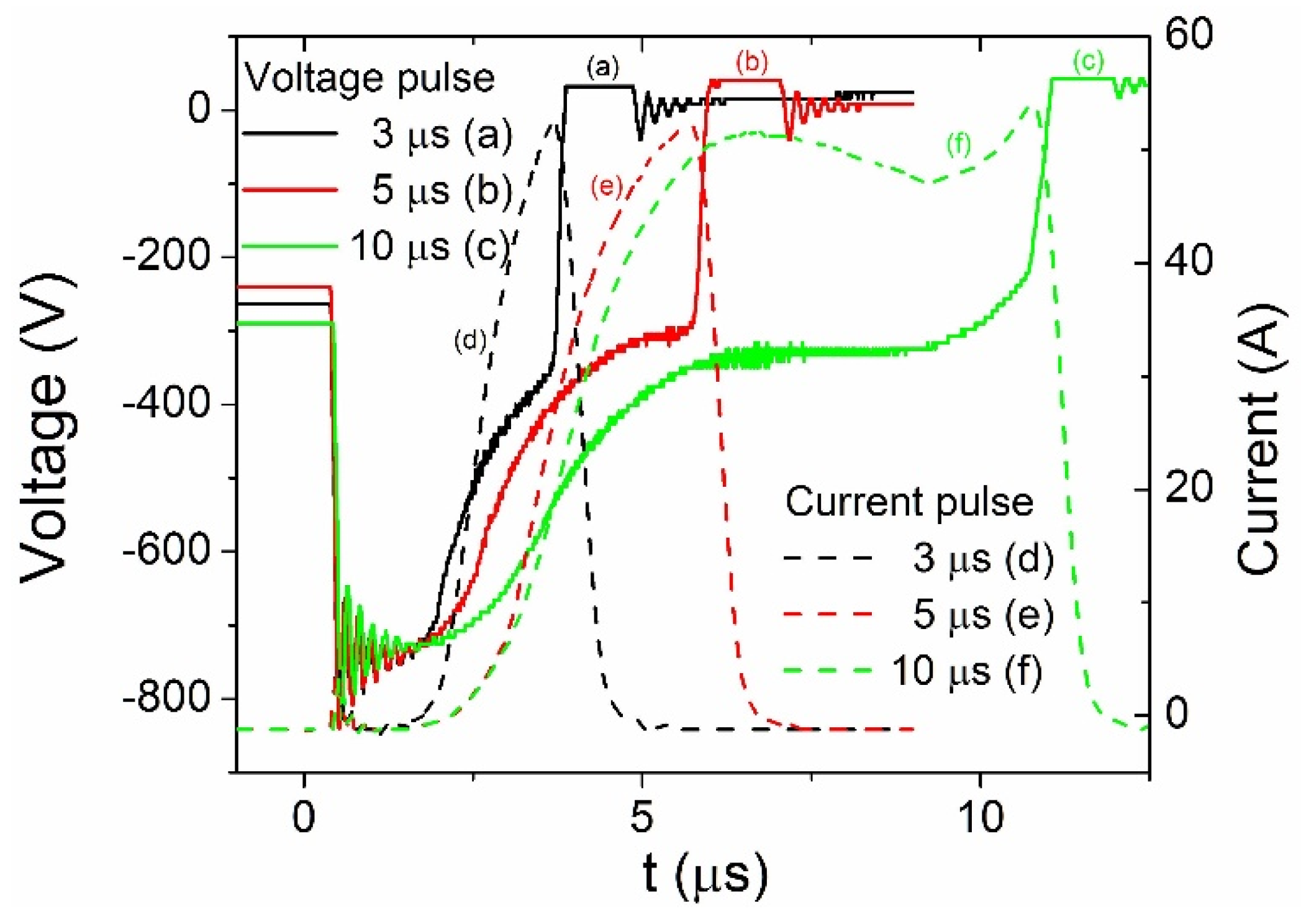
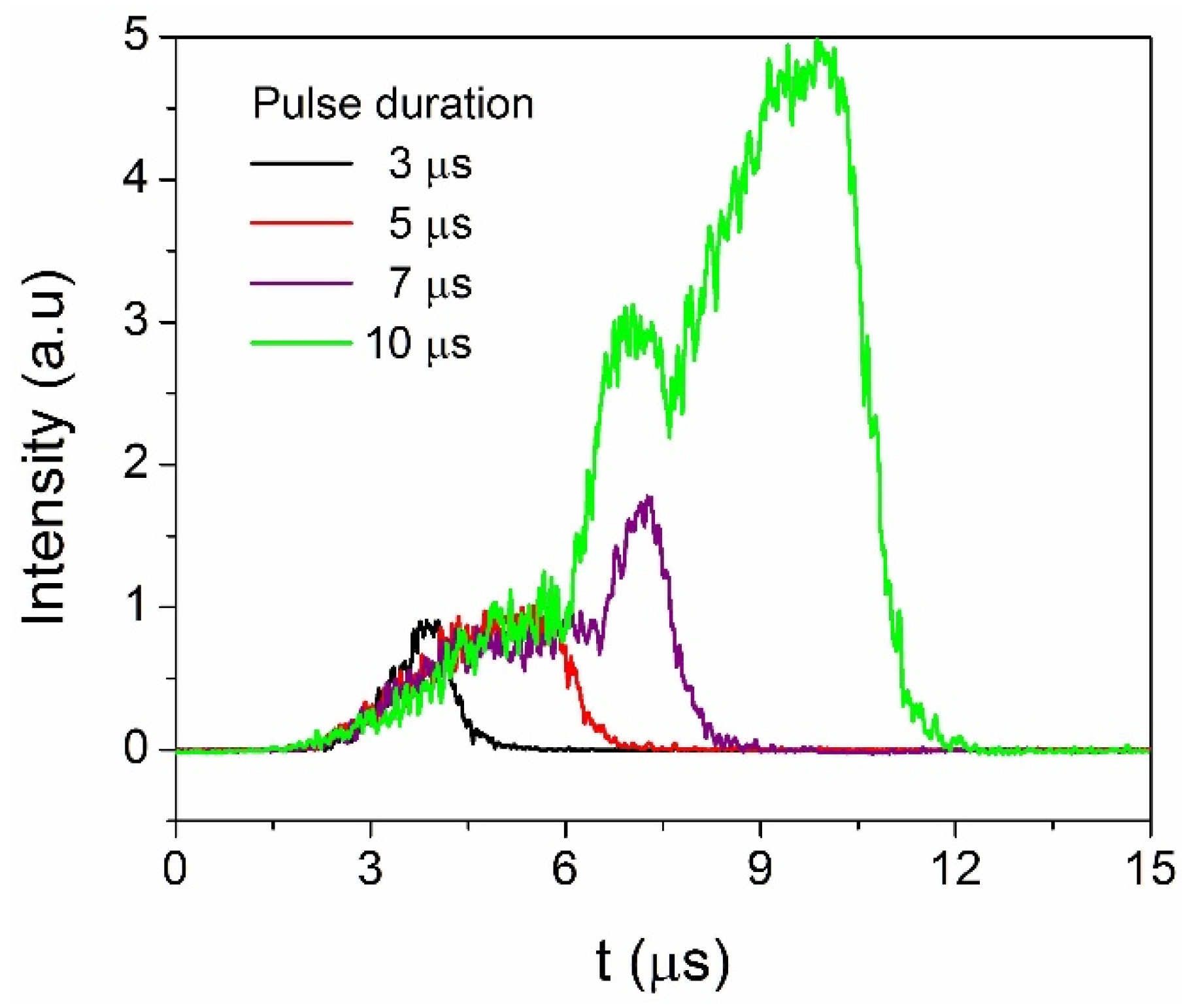
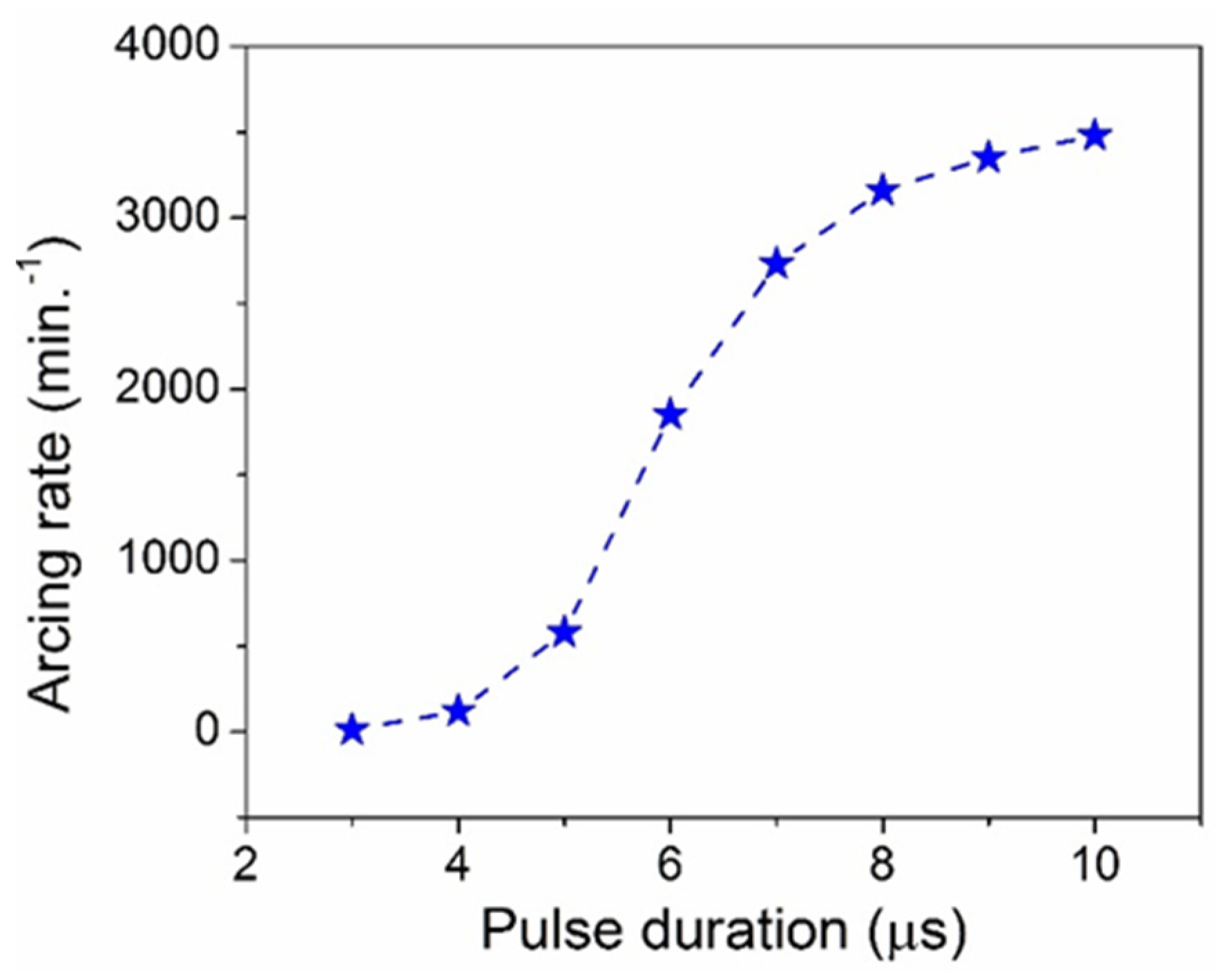
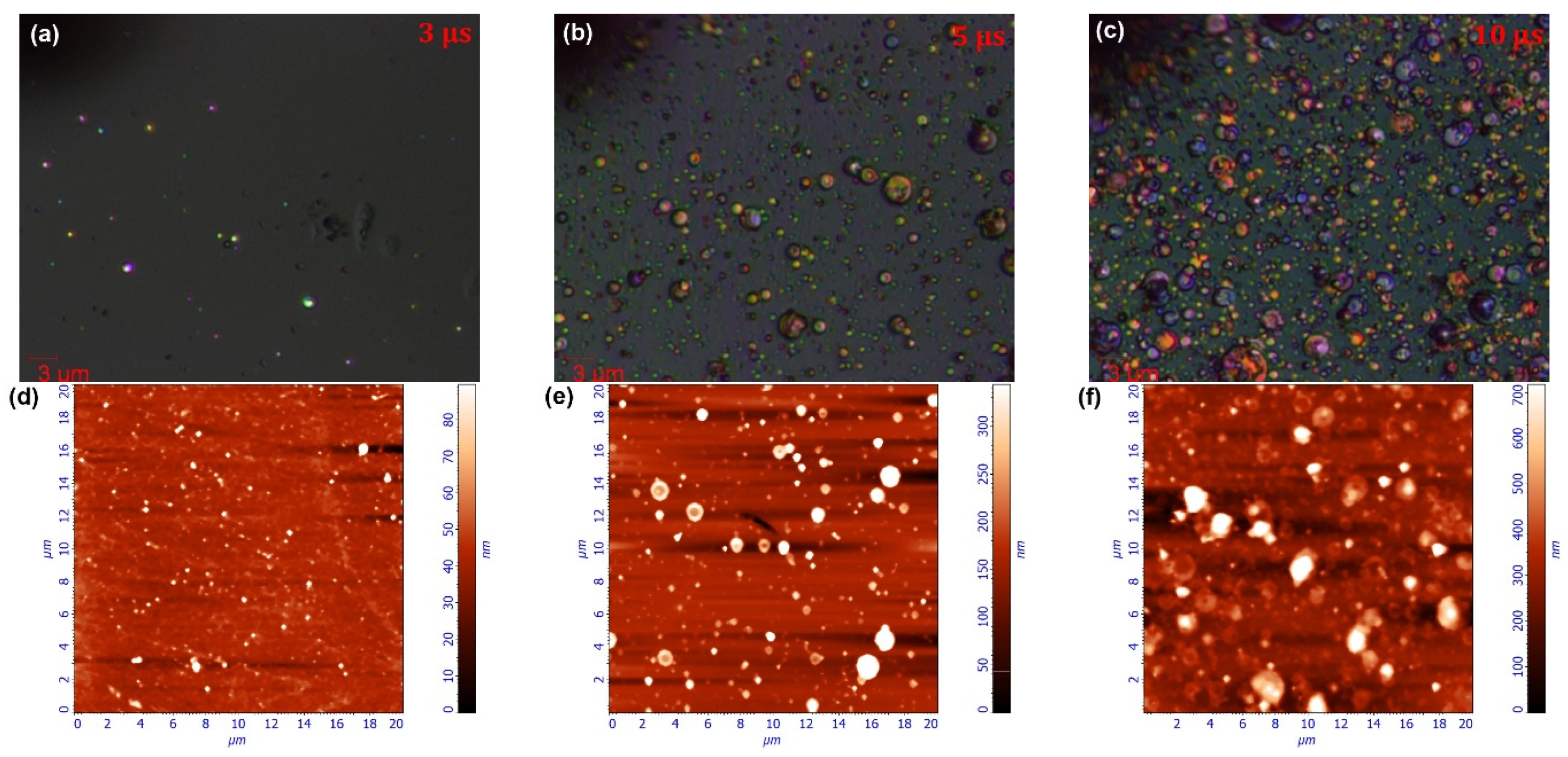
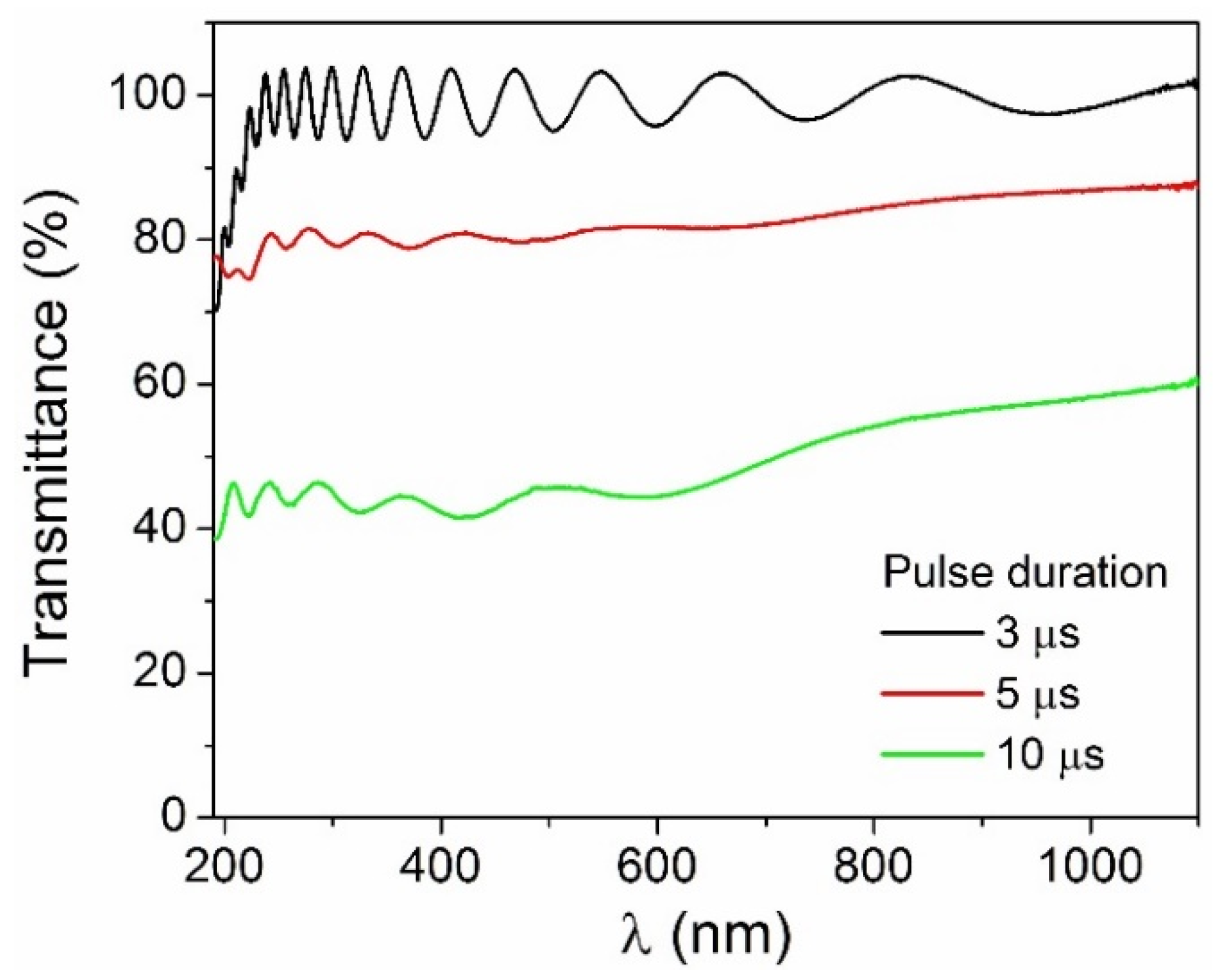
| τ (µs) | H (GPa) | E (GPa) | H/E | H3/E2 | LC1 (N) | LC2 (N) | LC3 (N) |
|---|---|---|---|---|---|---|---|
| 3 | 9.27 ± 0.26 | 67.35 ± 5.48 | 0.138 | 0.176 | 10.5 ± 0.88 | 12.2 ± 0.54 | 14.80 ± 0.42 |
| 5 | 6.51 ± 0.66 | 85.56 ± 5.32 | 0.076 | 0.038 | 8.50 ±0.85 | 9.91 ± 0.96 | 12.00 ± 0.65 |
| 10 | 5.25 ± 0.36 | 93.10 ± 6.23 | 0.062 | 0.020 | 0.45 ± 0.05 | 1.14 ± 0.10 | 5.01 ± 0.53 |
© 2020 by the authors. Licensee MDPI, Basel, Switzerland. This article is an open access article distributed under the terms and conditions of the Creative Commons Attribution (CC BY) license (http://creativecommons.org/licenses/by/4.0/).
Share and Cite
Tiron, V.; Velicu, I.-L.; Matei, T.; Cristea, D.; Cunha, L.; Stoian, G. Ultra-Short Pulse HiPIMS: A Strategy to Suppress Arcing during Reactive Deposition of SiO2 Thin Films with Enhanced Mechanical and Optical Properties. Coatings 2020, 10, 633. https://doi.org/10.3390/coatings10070633
Tiron V, Velicu I-L, Matei T, Cristea D, Cunha L, Stoian G. Ultra-Short Pulse HiPIMS: A Strategy to Suppress Arcing during Reactive Deposition of SiO2 Thin Films with Enhanced Mechanical and Optical Properties. Coatings. 2020; 10(7):633. https://doi.org/10.3390/coatings10070633
Chicago/Turabian StyleTiron, Vasile, Ioana-Laura Velicu, Teodora Matei, Daniel Cristea, Luis Cunha, and George Stoian. 2020. "Ultra-Short Pulse HiPIMS: A Strategy to Suppress Arcing during Reactive Deposition of SiO2 Thin Films with Enhanced Mechanical and Optical Properties" Coatings 10, no. 7: 633. https://doi.org/10.3390/coatings10070633
APA StyleTiron, V., Velicu, I.-L., Matei, T., Cristea, D., Cunha, L., & Stoian, G. (2020). Ultra-Short Pulse HiPIMS: A Strategy to Suppress Arcing during Reactive Deposition of SiO2 Thin Films with Enhanced Mechanical and Optical Properties. Coatings, 10(7), 633. https://doi.org/10.3390/coatings10070633









